 W
WA decorative or ornamental knot is an often complex knot exhibiting repeating patterns. A decorative knot is generally a knot that not only has practical use but is also known for its aesthetic or ornamental qualities. Often originating from maritime use, "decorative knots are not only serviceable and functional but also enhance the ship-shape appearance of any vessel." Decorative knots may be used alone or in combination, and may consist of single or multiple strands.Though the word decorative sometimes implies that little or no function is served, the craft of decorative knot tying generally combines both form and function.
 W
WAn Austrian knot ; alternatively warrior's knot or Vitézkötés; is an elaborate design of twisted cord or lace worn as part of a dress uniform, usually on the lower sleeve. It is usually a distinction worn by officers; the major exception is the hussars, in which Austrian knots are worn by all ranks. British cadet under officers wear Austrian knots as part of their rank insignia.
 W
WThe basket weave knots are a family of bend and lanyard knots with a regular pattern of over–one, under–one. All of these knots are rectangular and lie in a plane. They are named after plait-woven baskets, which have a similar appearance.
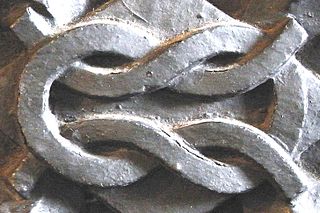 W
WThe Bourchier knot is a variety of heraldic knot. It was used as a heraldic badge by the Bourchier family, whose earliest prominent ancestor in England was John de Bourchier, a Judge of the Common Pleas, seated at Stanstead Hall in the parish of Halstead, Essex. He was the father of Robert Bourchier, 1st Baron Bourchier (d.1349), Lord Chancellor of England. The various branches of his descendants held the titles Baron Bourchier, Count of Eu, Viscount Bourchier, Earl of Essex, Baron Berners, Baron FitzWarin and Earl of Bath. The knot should perhaps have been called the "FitzWarin knot" as according to Boutell (1864) the device was first used by the FitzWarin family, whose heir was the Bourchier family.
 W
WA button knot is a knot that forms a bulge of thread. Button knots are essentially stopper knots, but may be esthetically pleasing enough to be used as a button on clothes.The single-strand button is a third type of knob knot, in which the working end leaves the knot at the neck, parallel with the standing part, so that the two parts, or ends, together form a stem. The lay of the two ends is the same, and the knot is symmetrical throughout.
 W
WCarpet pages are a characteristic feature of Insular illuminated manuscripts. They are pages of mainly geometrical ornamentation, which may include repeated animal forms, typically placed at the beginning of each of the four Gospels in Gospel Books. The designation "carpet page" is used to describe those pages in Christian, Islamic, or Jewish illuminated manuscripts that contain little or no text and which are filled entirely with decorative motifs. They are distinct from pages devoted to highly decorated historiated initials, though the style of decoration may be very similar.
 W
WThe carrick mat is a flat woven decorative knot which can be used as a mat or pad. Its name is based on the mat's decorative-type carrick bend with the ends connected together, forming an endless knot. A larger form, called the prolong knot, is made by expanding the basic carrick mat by extending, twisting, and overlapping its outer bights, then weaving the free ends through them. This process may be repeated to produce an arbitrarily long mat.
 W
W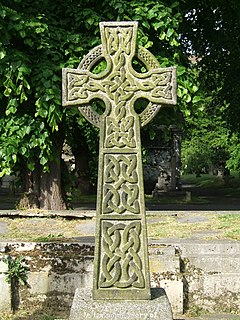 W
WCeltic knots are a variety of knots and stylized graphical representations of knots used for decoration, used extensively in the Celtic style of Insular art. These knots are most known for their adaptation for use in the ornamentation of Christian monuments and manuscripts, such as the 8th-century St. Teilo Gospels, the Book of Kells and the Lindisfarne Gospels. Most are endless knots, and many are varieties of basket weave knots.
 W
WChinese button knot is essentially a knife lanyard knot where the lanyard loop is shortened to a minimum, i.e. tightened to the knot itself. There emerges therefore only two lines next to each other from the knot: the beginning and the end. The knot has traditionally been used as a button on clothes in Asia, thus the name.The Chinese Button Knot is worn throughout China on underwear and night clothes. Buttons of this sort are more comfortable to lie on and to rest against compared to common bone and composition buttons, and they cannot be broken even by the laundry. A Chinese tailor ties the knot without guide, flat on his table. But one may be more quickly and easily tied in hand by a modification of the sailor’s method of tying his knife lanyard knot (#787). The two knots are tied alike, but they are worked differently.
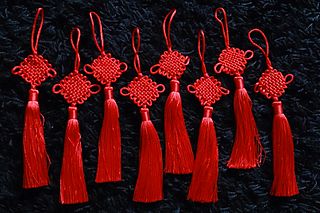 W
WChinese knotting is a decorative handcraft art that began as a form of Chinese folk art in the Tang and Song dynasty in China. The technique was later popularized in the Ming dynasty and subsequently spread to Japan, Korea, Singapore and other parts of Asia. This art is also called "Chinese traditional decorative knots". In other cultures, it is known as "decorative knots".
 W
WThe Croatian interlace or Croatian wattle, known as the pleter or troplet in Croatian, is a type of interlace, most characteristic for its three-ribbon pattern. It is one of the most often used patterns of pre-romanesque Croatian art. It is found on and within churches as well as monasteries built in early medieval Kingdom of Croatia between the 9th and beginning of the 12th century. The ornamental strings were sometimes grouped together with animal and herbal figures.
 W
WThe diamond knot is a knot for forming a decorative loop on the end of a cord such as on a lanyard. A similar knot, also called the diamond knot, is a multistrand stopper knot, that is similar in appearance. To avoid confusion, it is advisable to call this knot the knife lanyard knot. This knot is a four strand diamond knot implemented in two strands. The knife lanyard knot is "tied alike" the Chinese button knot, "but they are worked differently."The sailor's knife lanyard knot, also called marling-spike lanyard knot, single-strand diamond knot, two-strand diamond knot, and Bosun's whistle knot.
 W
WThe endless knot or eternal knot is a symbolic knot and one of the Eight Auspicious Symbols. It is an important symbol in both Jainism and Buddhism. It is an important cultural marker in places significantly influenced by Tibetan Buddhism such as Tibet, Mongolia, Tuva, Kalmykia, and Buryatia. It is also found in Celtic and Chinese symbolism.
 W
WThe fiador knot is a decorative, symmetrical knot used in equine applications to create items such as rope halters, hobbles, and components of the fiador on some hackamore designs. As traditionally described, it is a four strand diamond knot in which six of the eight ends loop back into the knot, thus allowing it to be tied with a single line. While a specific knot is discussed in this article, the fiador knot has also been treated as an entire class of multi-strand knots similarly made with a single line.
 W
WThe friendship knot is a decorative knot which is used to tie neckerchieves, lanyards and in Chinese knotting.
 W
WThe Good luck knot can be seen in images of the knot carved on a statue of the Asian Goddess of Mercy, Guanyin, which was created between AD 557 and 588, and later found in a cave in northwest China
 W
WThe Harrington knot is a decorative heraldic knot, the badge of the Harrington family. It is in essence identical to the fret.
 W
WThe Heneage knot is a decorative heraldic knot, the badge of the Heneage family of Lincolnshire, England. It was awarded to Sir Thomas Heneage by Queen Elizabeth I in 1594.
 W
WA heraldic knot is a knot, unknot, or design incorporating a knot used in European heraldry. While a given knot can be used on more than one family's achievement of arms, the family on whose coat the knot originated usually gives its name to the said knot. These knots can be used to charge shields and crests, but can also be used in badges or as standalone symbols of the families for whom they are named. The simplest of these patterns, the Bowen knot, is often referred to as the heraldic knot in symbolism and art outside of heraldry.
 W
WThe Hinckaert knot, a type of decorative unknot, is a heraldic knot used primarily in Dutch heraldry. It is most notable for its appearance on the Hinckaert family heraldic badge, where a semi-angular form is used as canting arms, a common practice with heraldic badges.
 W
WThe Hungerford or Hastings knot is a heraldic knot used as an heraldic badge in English heraldry by the Hungerford and Hastings families. The binding together of a Hungerford sickle and a Peverell garb (wheatsheaf) with the Hungerford knot commemorates the marriage between the Hungerfords and the Peverells in the early 15th century.
 W
WIn the visual arts, interlace is a decorative element found in medieval art. In interlace, bands or portions of other motifs are looped, braided, and knotted in complex geometric patterns, often to fill a space. Interlacing is common in the Migration period art of Northern Europe, especially in the Insular art of Ireland and the British Isles and Norse art of the Early Middle Ages and in Islamic art.
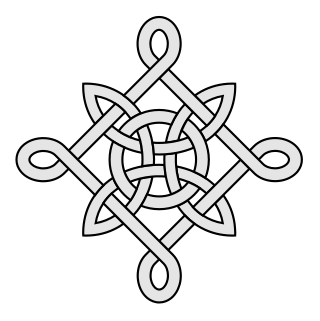 W
WThe Lacy or de Lacy knot is a decorative heraldic knot, the badge of the de Lacy family. It features in the crest of the borough of Burnley and heraldic badge of Kirklees.
 W
WLào zi or Tāo zi is an ancient appellation in China refers to knotting craft. In ancient literature, the words Lào zi is actually Chinese knotting, however, the name of Chinese knotting is summarised by Lydia Chen in 1980s. The two of the words "Lào zi" and "Tāo zi" means the same in many case, Lào is specific meaning of knotting, enmeshing, and wraping; and Tāo means lace or flat ribbon woven from silk thread that can decorate clothing.
 W
WA Matthew Walker knot is a decorative knot that is used to keep the end of a rope from fraying. It is tied by unraveling the strands of a twisted rope, knotting the strands together, then laying up the strands together again. It may also be tied using several separate cords, in which case it keeps the cords together in a bundle. The traditional use of the knot is to form a knob or "stopper" to prevent the end of the rope from passing through a hole, for instance in rigging the lanyards which tension the shrouds on older sailing ships with standing rigging of fiber cordage.
 W
WA monkey's fist or monkey paw is a type of knot, so named because it looks somewhat like a small bunched fist/paw. It is tied at the end of a rope to serve as a weight, making it easier to throw, and also as an ornamental knot. This type of weighted rope can be used as a hand-to-hand weapon, called a slungshot by sailors. It was also used in the past as an anchor in rock climbing, by stuffing it into a crack. Nowadays it is still sometimes used in sandstone, e.g., the Elbe Sandstone Mountains in Germany.
 W
WThe Pan Chang Knot is one of the eight symbols of Buddhism. It communicates that religion’s belief in a cycle of life with no beginning and no end. It was illustrated in a painting of the Emperor Xiaozhong that is now in the Palace Museum in Beijing. The knot is also known as the Mystic Knot, and is believed to impart good fortune to those who wear and observe it. It is an intricate knot that forces the tyer to think in three dimensions.
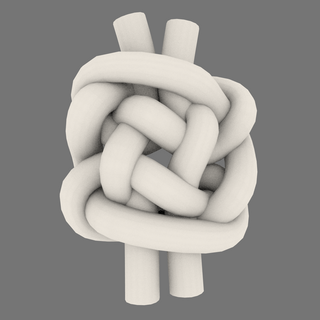 W
WThe Plafond knot, with its spiral-like center and rectangular border, was inspired by the decorations found on the dome-like central sections of ceilings in Chinese temples and palaces. The ceilings, which are divided into nine rectangular sections, three across and three deep, each have a domed apex composed of a circular design filled with auspicious motifs surrounded by a complementary motif which radiates out to the rectangular border. This effect is echoed in the plafond knot, which is made by hooking up and tightening a number of flat knots.
 W
WThe Savoy knot, a type of decorative knot, is a heraldic knot used primarily in Italian heraldry. It is most notable for its appearance on the heraldic badge of the House of Savoy, where it is accompanied by the motto Stringe ma non costringe, "It tightens, but does not constrain". The Cavendish knot is an identical heraldic knot. In shape, the Savoy knot is comparable to a figure eight.
 W
WSennit is a type of cordage made by plaiting strands of dried fibre or grass. It can be used ornamentally in crafts, like a kind of macrame, or to make straw hats. Sennit is an important material in the cultures of Oceania, where it is used in traditional architecture, boat building, fishing and as an ornamentation.
 W
WSolomon's knot is a traditional decorative motif used since ancient times, and found in many cultures. Despite the name, it is classified as a link, and is not a true knot according to the definitions of mathematical knot theory.
 W
WSquare knot insignia are embroidered cloth patches that represent awards of the Scout associations throughout the world.
 W
WA Turk's head knot, more commonly known as a sailor's knot, is a decorative knot with a variable number of interwoven strands forming a closed loop. The name refers to a general family of knots, not an individual knot. While this knot is typically made around a cylinder, it can also be formed into a flat, mat-like shape. Some variants can be arranged into a roughly spherical shape, akin to a monkey's fist knot.
 W
WThe Wake knot or Ormond knot is an English heraldic knot used historically as an heraldic badge by the Wake family, lords of the manor of Bourne in Lincolnshire and also by the Butler family, Earls of Ormond.
 W
WA wall and crown knot is a decorative kind of rope button. The original use of the knot was to put at the end of the ropes on either side of a gangway leading onto a ship as stoppers.672. ...the wall and crown knot...was mentioned by Moore in 1801. The wall is tied first, and then a crown is superimposed.
 W
W W
W W
W W
W W
W